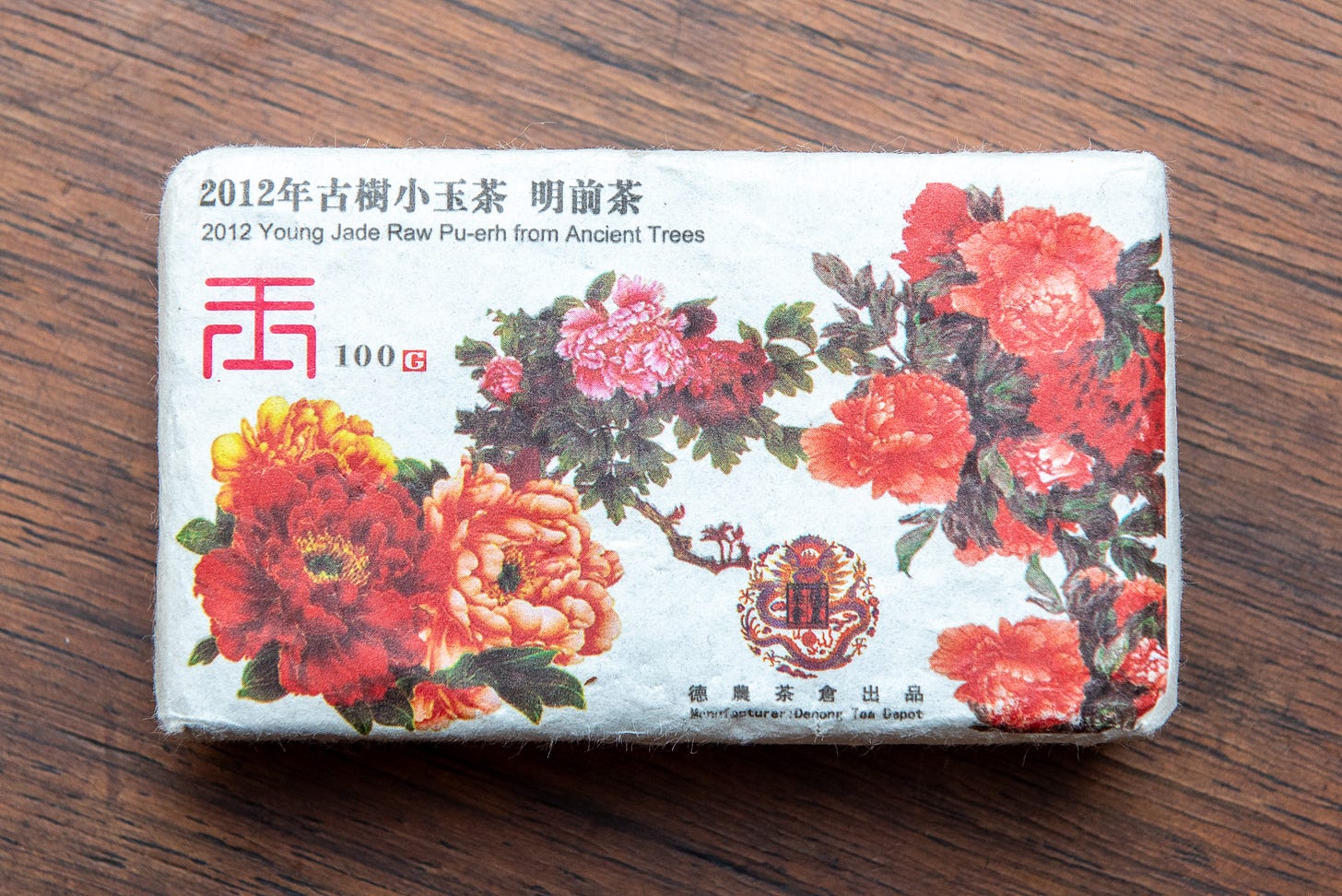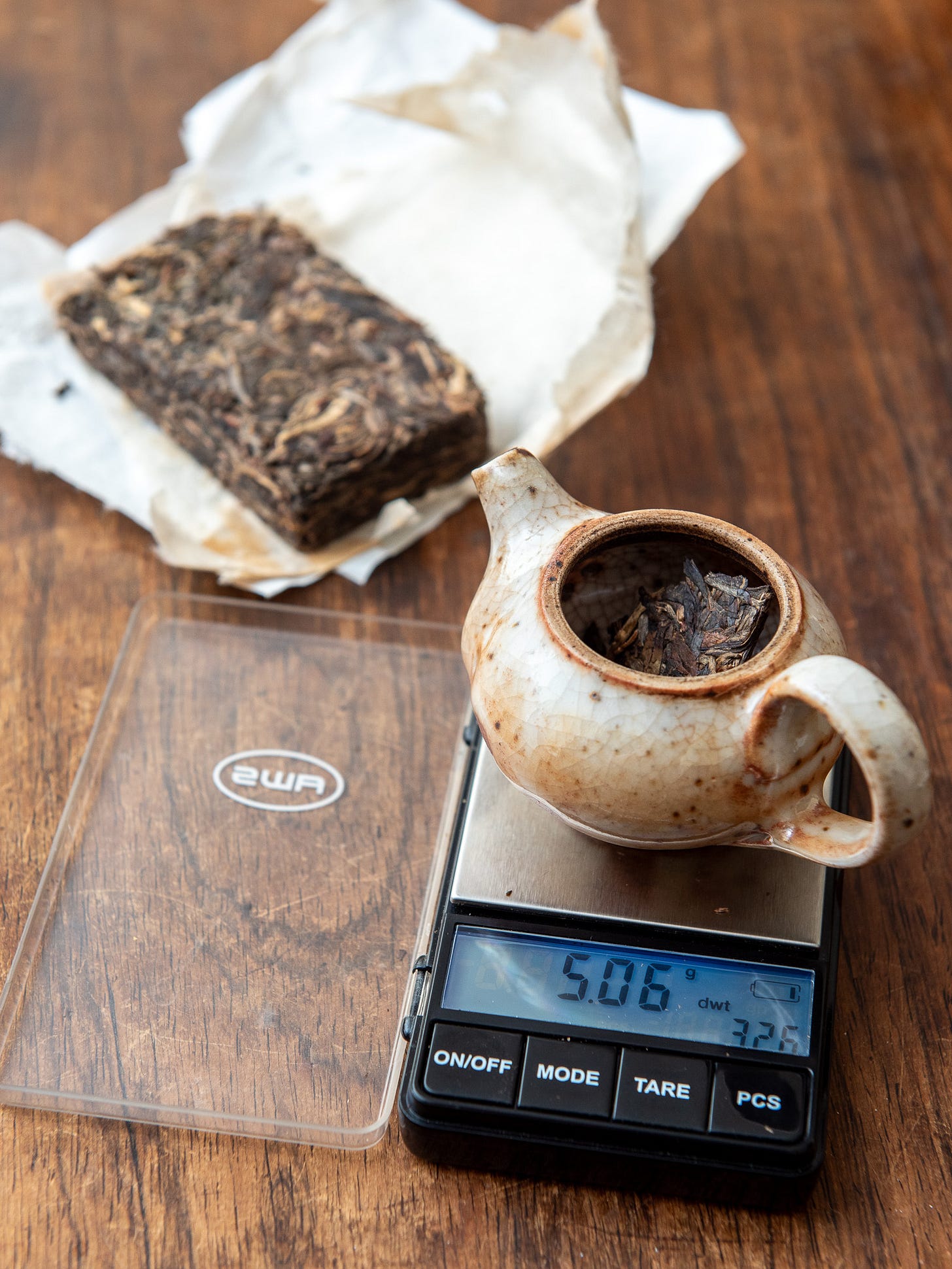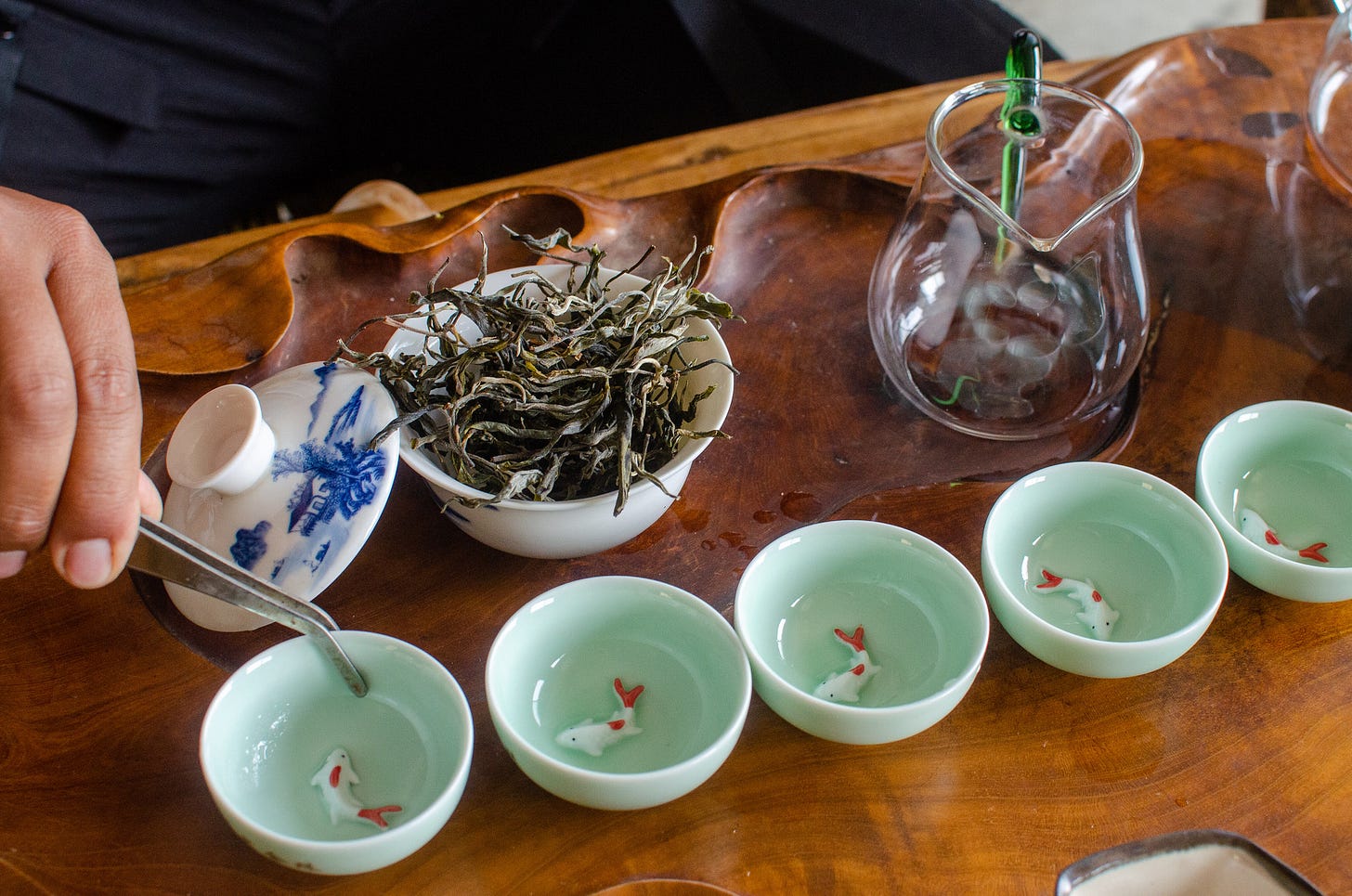New readers: Welcome to Leafhopper. I’m so happy you’re here. This week, we taste something special that I dug up from a deep corner of my tea storage. We also explore two prickly, intertwined issues: what is good tea, and what does it cost?
There’s no paywall for this week’s deep dive essay, so readers can get a better sense of what future ones will be. After this week, deep dives will be exclusive for paying subscribers. Consider upgrading your subscription to retain access to them! If you can't afford the cost of a subscription but have a passion for tea and desire to learn more, email me and we can make it happen.
A tea to make your knees weak
The tea: Denong Tea 2012 Young Jade Ming Qian Raw Puer, sold by Bana Tea Company. $166 for 100g.
If you’re new to aged puer (rhymes with “pursuer”), don’t buy this first. Sample your way through less expensive teas, preferably from sellers who specialize in the category. Read about how puer is made. Get a taste for various ages, producer names, and storage environments. If three months pass and you’re still drinking puer, go ahead and look at some teas in this price range.
If you’ve been drinking puer for a while and know what you like, I’ll say this: I bought this tea on sale in 2015 as a Chanukah present to myself, when it retailed for 73 fewer dollars than it costs now. Consult your budget and plan accordingly.
To be clear: I think this is good tea and recommend you drink it. How does it compare with similar puer teas in 2024? Is it a good deal? I’m not sure. I try not to approach tea shopping with an optimized game theory strategy. I wanted to highlight this tea because I think it’s inarguably “good,” and yet a prime example of the contentious opinions that come with specialized luxuries like high end tea.
You may taste notes of caramel cotton candy, roasted grain, and the herbal-medicine tinge of grass jelly. Or not, I don’t know what your flavor references are. A pleasing bitterness called ku wei builds, with a clean finish and almost no astringency. The brew clings to the sides of my mouth like grappa in a swirled glass. A few moments after swallowing, a cool sweetness called hui gan emerges from my throat.
I find this tea noteworthy for the somatic effects I experience more than its flavors. In one session, the sides of my head tingle and I notice warm pulses in my chest. During another, my hips and knees become loose and limber, as if my connective tissues were dissolving into gelatin-rich soup. I tend to hyperextend my legs by sitting cross legged, and I like how this tea makes them feel. Your mileage may vary.
The source: Denong is the rare puer brand with an English website, and specializes in high end boutique puer from elder trees. They even have a storefront in the Los Angeles area. The company purchases processed leaves from farms and then blends and presses them into a series of named productions, such as the 2012 Young Jade Ming Qian Raw Puer. To break that down: 2012 is the year the tea was pressed; Young Jade is a pretty name for the production line; Ming Qian means that the leaves were picked in the earliest days of spring, before the Qingming tomb sweeping festival, when tea trees swell with nutrients from winter dormancy; and Raw is the style of this particular Puer tea.
Bana Tea Company is one of my favorite sources of puer in the Unites States. It’s a retirement project for owner Linda Louie, which is my polite way of saying that she’s not running the business to maximize returns for shareholders. I’ve written about Linda a few times for Imbibe Magazine, and she spoke with an editor there to make a solid primer about puer tea in general. We’ve only been able to drink tea together a couple times, but she’s a warm, generous educator and tea advocate. Linda selects teas with a particular depth and panache that I’ve come to enjoy, including several Denong productions.
To brew: If I’m drinking an expensive tea for myself, I use small teawares to stretch my supply. Here are 5 grams of tea for a wee 50 milliliter pot (1g/10ml), carefully pried from the densely compressed brick with a pointy puer pick (sold separately). Heat your empty pot and cup with boiling water, then resurrect the leaves from their compressed and aged slumber. The first momentary steep is called a rinse. Its purpose is to begin hydrating the leaves and it’s usually discarded. Set subsequent steeps for 10 seconds, adding time as you go. If a cup is too weak, steep the next one longer; if too strong, go shorter. This tea will yield many infusions. Give yourself an hour for the session.
What should we pay for good tea?
How do we define good tea in the first place? Is it refreshing to drink? Complex in flavor? Is it processed properly? Made according to a regional tradition, or in service of a positive mission? Does the producer fairly compensate their workers? How do they treat their environment?
It’s important to ask these questions, because what’s called “good” tea often costs more, and we should know what is and isn’t included in that price. I believe there’s good tea at every price point, depending on which “good” we’re talking about, and what you want to get out of a tea. The higher the price, the higher the stakes feel. Am I getting to taste something special, or am I getting ripped off?
All this is especially relevant for puer, a fermented and aged tea from Yunnan Province in southwestern China, and less officially from bordering gardens in Laos, Vietnam, Myanmar, and Thailand. There is dirt cheap puer and jaw-dropping expensive puer. The brew can taste coarse and strange to newcomers; weirdly savory for a tea. It’s said to improve with age—sometimes, for some teas, if they’re “good.” A speculative investment market caters to this precept, which has birthed and exacted many fortunes. Puer is often sold in compressed cakes or bricks, a throwback to when people and mules transported tea across mountains, burdened with great saddlebags. It’s not for everyone. There are certainly more friendly teas to drink, with more expressive flavors. But for some who’ve spent their lives drinking the world through tea, puer is often where they settle down.
Delicacies like high priced puer drift from the material world into a realm of fantasy where cost, price, and value can lose all relationship to each other. I’m reminded of an episode of Futurama, where the penniless alien Dr. Zoidberg receives a $300 tax refund check and decides to spend his new fortune like a rich person. He visits a fine dining restaurant and is presented with foie gras and caviar, then takes a derisive sniff. “Goose liver? Fish eggs? Feh!” he exclaims. “Where’s the goose! Where’s the fish!”
When I was first learning about tea, I’d stumble on a new seller’s website and furrow my brow as I scrolled through their products. Names jumbled together. I couldn’t see why a tea cost what it did, and why the prices varied so much.
The Young Jade was one of four 100-gram Denong tea bricks that I bought from Bana Tea Company in a tasting set. The Jingmai and sold-out Nannuo bricks were less expensive, at 60 to 70% the price of the Young Jade. The Lao Banzhang cost almost as much as the other three bricks put together; it currently retails for $329. That’s about four times the market price of silver.
I asked Linda of Bana Tea why these bricks cost what they do, and why their prices have nearly doubled since 2015. One reason, she explained, is warehousing: aged tea has to age somewhere, in a controlled environment, and that costs money. Another is the rising cost of new harvest teas from select regions. Before it got popular in the late 2000s, tea from Lao Banzhang cost about $7 per kilogram, Linda says. This year its price has risen to $1,400. “The rise in cost of raw materials increases the replacement cost of a tea.”
Lao Banzhang tea is renowned for its punchy bitterness and intense somatic effects. It’s also the one of the trendiest names in puer, so wealthy customers with money to burn are happy to drive up the price. According to Linda, the Young Jade brick is a blend of puer from Lao Banzhang as well as Hekai and Xigui—two other pricy, in-demand regions. Like the Young Jade, the Denong Jingmai and Nannuo bricks are also made from a limited supply of early spring leaves. I’ve had amazing tea from these regions. There’s just not as much demand.
In truth, I prefer the taste of the Jingmai and Nannuo teas. The Jingmai brick has a spicy-sweet, honey and rose vibe that always puts a smile on my face. If you don’t know what you’re in for, the Young Jade’s resounding bitterness may turn you off. But the Young Jade makes my knees weak in a way these Jingmai and Nannuo bricks do not. Maybe you want to feel that. Maybe you don’t, and you’re thinking a ruby-red hibiscus lemonade would hit the spot without any of this fuss!
I was curious if the skyrocketing price of puer teas had trickled down to the workers that pluck the leaves. Small tea farms in China are often tended by families that hire seasonal migrant workers during the busy seasons. Labor rights and protections vary. Linda says she’s heard from contacts that the price of white tea in Fujian Province has increased recently, due in part to rising labor costs, though she couldn’t speak to the labor situation in Yunnan. Aged puer goes through many hands between the field and the point of sale, making it difficult to peg down the working conditions and profit-sharing behind any particular batch.
Over in the Darjeeling hills of India, tea workers are among the few in the global industry that are represented by robust unions. The region is still rife with labor abuses, and earnings gaps across farms’ rigid hierarchies are stark, but the business is much more transparent to buyers, and it’s easier to see how the cost of labor factors into the final price of a given tea.
In Japan, the cost of labor is such an issue that tea farmers lead the global industry in automation. With mechanical harvesters and sophisticated processing equipment, a small family can run a farm with relatively little hired help. As a result, even the priciest Japanese teas may cost a fraction of what buyers pay for fine puer.
Since my goal is to complicate the relationship between a tea’s price and its “goodness,” I don’t have easy answers for how to decide if a given tea is worth it. Yes, there is a global tea market, but specialty teas are regional products with their own quirks. Darjeeling gardens are large enough to comfortably shoulder the cost of organic certification—something most small tea farmers can’t afford, even if their practices are similar. That’s because Darjeeling gardens sell a lot of product to the European Union and United States, where organic teas are in demand. Good luck finding anything reliable about the ecology behind a typical puer cake; it’s simply not as great a priority for the puer market.
Even if we limit our standards to questions of taste, the definition of good tea is elusive. Mine comes down to something intangible: good tea makes you feel good, and with practice, you learn to recognize what that feels like. Teas from Japan, Darjeeling, and Yunnan have all made me feel good in different ways. The Denong Young Jade puer makes me feel good in an especially profound way.
In a post about the limits of assessing a tea by its flavor, tea historian and blogger Lawrence Zhang writes:
From observations and discussions with other tea drinkers, I think after a while, we all move, slowly, towards a deeper and more subtle appreciation of tea, and that means that we start moving away from just looking at what the tea tastes like, and put more emphasis on what the tea feels like. Good (and usually expensive) teas invariably feel good in a way that inferior teas do not. They don’t always taste all that different, however.
The older I get, the more valuable that feeling is to me. And I find that’s what governs the price I’m willing to pay.












Remember a couple of weeks ago you said you appreciate a certain roughness in a tea vendor’s website? Well, at the bottom of the ABOUT US page in Denong’s English language site you can see “Liquid error (layout/theme line 125): Could not find asset snippets/ajaxify-car.liquid”
Interesting thinking about the comparatively 'laid back' attitude towards labour practices in Yunnan tea production. And all worthwhile qualities for 'good' tea; would that I could afford to drink tea that feels good all the time 😄 As much as I envy the thought of buying a lifetime's worth of truly good tea for very little money in the early 2000s, I hope that the drastically rising costs are creating a better quality of life for farmers and producers